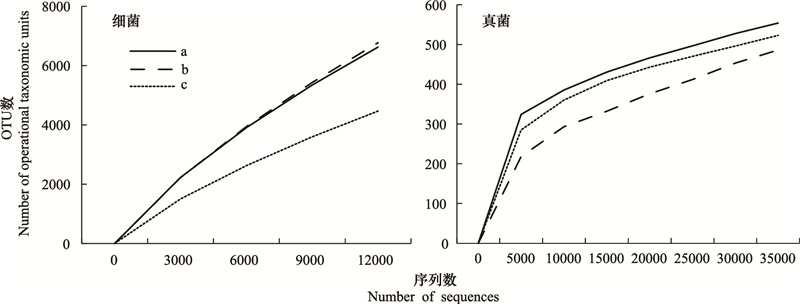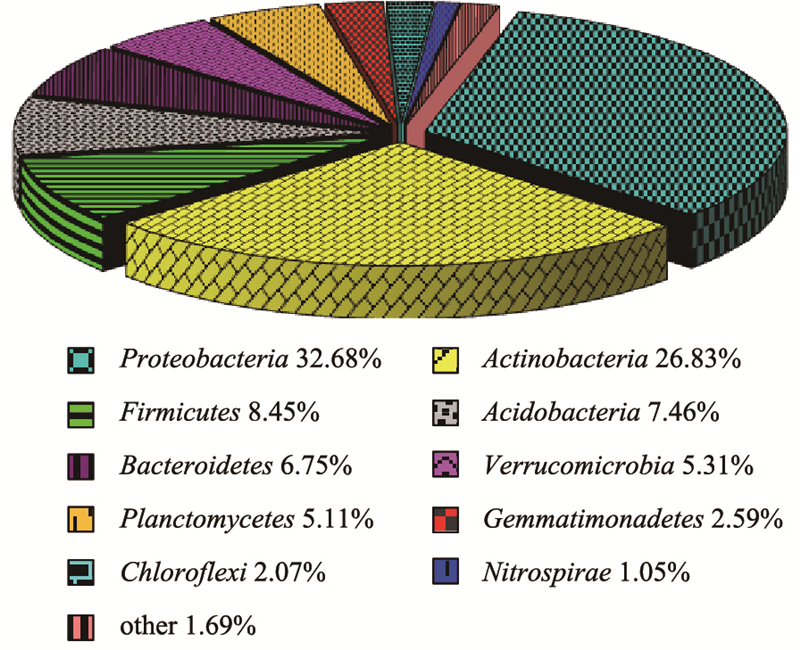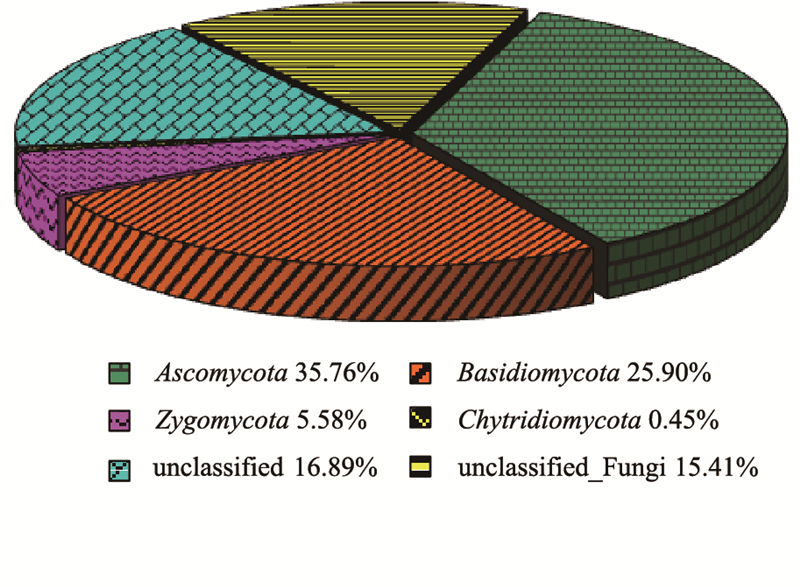文章信息
- 高雪峰, 韩国栋, 张国刚
- GAO Xuefeng, HAN Guodong, ZHANG Guogang.
- 短花针茅荒漠草原土壤微生物群落组成及结构
- Soil microbial community structure and composition of Stipa Breviflora on the desert steppe
- 生态学报. 2017, 37(15): 5129-5136
- Acta Ecologica Sinica. 2017, 37(15): 5129-5136
- http://dx.doi.org/10.5846/stxb201605100902
-
文章历史
- 收稿日期: 2016-05-10
- 网络出版日期: 2017-03-22
2. 内蒙古师范大学生命科学与技术学院, 呼和浩特 010020;
3. 天津师范大学生命科学学院, 天津 300387
2. College of Life Sciences and Technology, Inner Mongolia Normal University, Hohhot, 010020, China;
3. College of Life Sciences, Tianjin Normal University, Tianjin 300387, China
土壤微生物是草地生态系统的重要组成部分, 也是土壤生态环境中最为重要且对环境变化极其敏感的生物活性因子, 对土壤生态系统的健康状况与植被的生长发育都会产生重要影响, 对于草原生态系统的健康维护与植被的恢复也具有不可替代的作用[1]。土壤微生物群落结构和组成的多样性与均匀性不仅可提高土壤生态系统的稳定性与和谐性, 同时提高对抗土壤生态环境恶化的缓冲能力[2-3]。研究土壤微生物群落结构和多样性, 对于合理利用草原、恢复退化草地生态系统的生物学功能, 实现草地生态系统的可持续发展具有重要生态意义。
短花针茅荒漠草原是我国温带荒漠草原分布最集中、最具代表性的生态系统类型之一, 是草原向荒漠过渡的生态交错带, 是我国境内对全球变化反应较为敏感的生态系统地带, 是我国重要的畜牧业生产基地之一, 也是草地生态系统中生态安全的最主要组成部分[4-5]。目前有关草原系统的研究主要集中在地上部分[6-7], 而鲜为人知的地下部分制约草原生态系统的研究有待拓展。有限的研究也主要局限在放牧对土壤最为基本的理化性质影响的研究[8-9], 而有关短花针茅草原土壤微生物群落结构特征的研究则更少见有报道。本文采用高通量测序技术, 研究短花针茅荒漠草原土壤中微生物的物种组成、群落结构及多样性, 为进一步探讨荒漠草原土壤微生物的功能以及微生物资源的开发利用提供直接依据。
1 材料与方法 1.1 研究区概况试验区位于内蒙古自治区乌兰察布盟四子王旗境内的短花针茅荒漠草原。属典型的大陆性气候, 春季干旱多风, 夏季炎热, 年均降雨量280 mm, 降水量集中在5—8月, 草地类型为短花针茅(Stipa breviflora Griseb.)+冷蒿(Artemisia frigida Willd.)+无芒隐子草(Cleistogenes songorica Ohwi.)荒漠草原, 植被草层低矮、稀疏, 盖度为17%—20%, 植物种类组成较贫乏, 由20多种植物组成。土壤为淡栗钙土, 具有高钾、低隣和少氮的特点, 有机质含量较低, pH为7.80—7.99。土壤结构以砂粒所占比例最大, 粉粒和粘粒次之。土层厚度大约为1m左右, 土体坚硬, 渗透能力较差[10]。
1.2 土样采集于2014年8月在短花针茅荒漠草原选取了呈三角形的3个采样点a、b、c, 地理坐标为41°46 ′— 41°52′N、112°09′— 112°38 ′E, 样点之间距离约500 m。每个样点用土钻按5点取样法取0—30 cm土层土样, 混合均匀后合为一个土壤样品。土样装密封袋低温带回实验室, 去除植物根系和石块并过1mm筛用后于-18℃冰箱暂存。
1.3 土壤DNA提取、PCR扩增和高通量测序土壤DNA提取采用的是E.Z.N.ATM Mag-Bind Soil DNA Kit(美国OMEGA公司)试剂盒。细菌引物采用341F(5′-CCCTACACGACGCTCTTCCGATCTG-3′)和805R(5′-GACTGGAGTTCCTTGGCACCCGAGAATTCCA-3′), 对细菌16S rDNA基因V3-V4高变区进行PCR扩增[11]。真菌引物采用ITS1F(5′-CCCTACACGACGCTCTTCCGATCTN-3′)和ITS2-Rev(5′-GTGACTGGAGTTCCTTGGCACCCGAGAATTCCA-3′), 对真菌ITS1-ITS2区进行PCR扩增[12]。每一样品的引物均含有特异的Barcode序列用于区分样品序列。50 μL反应体系:10×PCR buffer 5μL, dNTP (10 mmol/L)0.5μL, Genomic DNA 10ng, Bar-PCR primer F(50umol/L) 0.5μL, Primer R (50 umol/L)0.5μL, Plantium Taq(5U/μL) 0.5μL。PCR扩增条件:94℃ 3min;94℃ 30s, 45℃ 20s, 65℃ 30s, 5个循环;94℃ 20s, 55℃ 20s, 72℃ 30s, 20个循环;72℃ 5 min。
PCR结束后, 引入Illumina桥式PCR兼容引物进行第二轮扩增。PCR体系:10×PCR buffer 5 μL, dNTP(10mmol/L) 0.5 μL, DNA 20 ng, primer F(50umol/L)0.5 μL, Primer R (50 umol/L)0.5μL, Plantium Taq(5 U/μL) 0.5 μL, 加水到50 μL。95℃ 30s;95℃ 15s, 55℃ 15s;72℃ 30s, 5个循环;72℃ 5 min。对PCR产物进行琼脂糖电泳, 并采用琼脂糖试剂盒(SK8192) 回收, 用Qubit 2.0 DNA检测试剂盒对回收的DNA精确定量, 每一样品DNA量取10 ng, 按1:1等量混合后采用Illumina公司的Miseq 2×300平台测序。
1.4 数据处理和分析高通量测序得到的原始数据经过FastQC软件进行质量控制, 然后用FLASH软件拼接, Prinseq软件过滤掉低质量的序列。将有效序列相似性≥97%的序列聚类成为OTU(Operational Taxonomic Units)。为了高效地得到样品中微生物组成的多样性信息, 从每个OTU中选择1条代表序列, 使用RDP classifier数据库为每条代表序列分配分类单元。再用QIIME软件进行单样品组成分析, 计算样品的Coverage和Alpha多样性, 包括Chao1指数、Shannon指数[13-15]。其中Coverage指样品文库的覆盖率, 其数值越高, 则样本中序列没有被测出的概率越低。群落丰富度用Chao指数描述, 其值越高表明群落物种的丰富度越高。而Shannon指数可反映样品的多样性程度, Shannon值越高, 表明群落物种的多样性越高。将样品中无法鉴定到这个分类水平的类群统称为未知类群(Unclassified), 将相对丰度低于1%的类群合并, 统称为其他类群(Other), 然后制作不同分类水平上的细菌和真菌类群的相对丰度图。
2 结果与分析 2.1 序列统计和微生物多样性为了解内蒙古短花针茅荒漠草原土壤微生物群落结构组成特点, 采用高通量测序技术对土壤微生物群落多样性进行了分析, 结果见表 1。
| 靶序列 Target |
序列数 Number of Sequences |
OTU数 OTUs |
覆盖度 Coverage/% |
香农指数 Shannon |
丰富度指数 Chao1 |
| 16S rDNA | 68307 | 13711 | 70.46±5.21 | 8.09±0.91 | 26971±8996 |
| ITS | 78667 | 5929 | 95.39±2.56 | 5.57±0.69 | 3767±693 |
短花针茅荒漠草原土壤细菌和真菌分别获得有效序列为68307和78667。细菌共产生OTUs 13711个, 与数据库比对不上的细菌OUT占总数的29.44%。真菌共产生5929个OTUs, 与数据库比对不上的真菌OTU占总数的4.61%。表明了荒漠草原土壤中还有较多新的细菌。从香农指数和丰富度指数来看, 短花针茅荒漠草原土壤微生物群落中, 细菌的种类和数量远高于真菌, 细菌在土壤微生物中占主体地位。这与作者之前通过平皿培养法分析短花针茅荒漠草原土壤微生物分布特征的结果基本一致[16]。
覆盖度反映了测序结果是否代表样本的真实情况。短花针茅荒漠草原土壤中细菌和真菌的覆盖度分别为70.46%和95.39%(表 1)。说明取样基本合理, 所测结果能够比较真实地反映土壤样品中的细菌和真菌群落。稀疏曲线反映了样品的测序深度, 可以用于评估测序量是否足以覆盖所有类群。由图 1可看出, 土壤细菌库容近似直线, 没有随序列数量的增加达到一个平台, 而土壤真菌的稀疏曲线基本趋于平缓。表明荒漠草原土壤真菌基本涵盖了土壤中所有真菌种群, 而荒漠草原土壤细菌没有获得细菌群落的全部种群, 仍有部分种类尚未被发现。

|
| 图 1 土壤细菌和真菌的稀疏曲线 Fig. 1 Rarefaction curve analysis of OTUs of the bacterial and fungi in soil |
对13711个OTUs的分类结果表明, 短花针茅荒漠草原土壤总数为68307个序列中, 隶属于29门57纲111目191科485属。在门水平至少隶属于29个不同的细菌门, 其相对丰度≥1%的共10个门(图 2)。其中Proteobacteria(变形菌门)32.68%和Actinobacteria(放线菌门)26.83%, 为土壤细菌中的优势菌种。其次为Firmicutes(厚壁菌门)8.45%、Acidobacteria(酸杆菌门)7.46%、Bacteroidetes(拟杆菌门)6.75%、Verrucomicrobia (疣微菌门)5.31%、Planctomycetes(浮霉菌门)5.11%、Gemmatimonadetes(芽单胞菌门)2.59%、Chloroflexi(绿弯菌门)2.07%和Nitrospirae(硝化螺旋菌门)1.05%, 其余19个门所占比例均低于1%, 共占1.69%。

|
| 图 2 门水平细菌菌群组成 Fig. 2 Bacterial composition at phylum level Protebacteria变形菌门Actinobacteria放线菌门Firmicutes厚壁菌门Acidobacteria酸杆菌门Bacteroidetes拟杆菌门Verrucoomicrobia疣微菌门Planctomycetes浮霉菌门Gemmatimonadetes芽单胞菌门Chloroflexi绿弯菌门Nitrospirae硝化螺旋菌门Other其他细菌 |
在纲水平隶属于57个不同的纲(表 2), 其中相对丰度≥2%的纲有15个。其中变形菌门的Gammaproteobacteria(γ-变形菌纲13.54%)和放线菌门的Thermoleophilia(嗜热油菌纲12.78%)所占比例最高。其次为Alphaproteobacteria(α-变形菌纲8.55%)、Acidobacteria (酸杆菌纲7.22%)、Betaproteobacteria(β-变形菌纲7.14%)、Actinobacteria(放线菌纲6.59%)等。
| 纲 Class |
相对丰度/% Relative abundance |
隶属的门 Member of phylum |
| Gammaproteobacteria (γ-变形菌纲) | 13.54 | Proteobacteria (变形菌门) |
| Thermoleophilia (嗜热油菌纲) | 12.78 | Actinobacteria (放线菌门) |
| Alphaproteobacteria (α-变形菌纲) | 8.55 | Proteobacteria (变形菌门) |
| Acidobacteria (酸杆菌纲) | 7.22 | Acidobacteria (酸杆菌门) |
| Betaproteobacteria (β-变形菌纲) | 7.14 | Proteobacteria (变形菌门) |
| Actinobacteria (放线菌纲) | 6.59 | Actinobacteria (放线菌门) |
| Clostridia (梭菌纲) | 5.07 | Firmicutes (厚壁菌门) |
| Sphingobacteriia (鞘脂杆菌纲) | 4.77 | Bacteroidetes (拟杆菌门) |
| Acidimicrobiia (酸微菌纲) | 3.84 | Actinobacteria (放线菌门) |
| Planctomycetacia (浮霉菌纲) | 3.82 | Planctomycetes (浮霉菌门) |
| Deltaproteobacteria (δ-变形菌纲) | 3.42 | Proteobacteria (变形菌门) |
| Bacilli (芽孢杆菌纲) | 3.12 | Firmicutes (厚壁菌门) |
| Spartobacteria | 3.07 | Verrucomicrobia (疣微菌门) |
| Gemmatimonadetes (芽单胞菌纲) | 2.59 | Gemmatimonadetes(芽单胞菌门) |
| Rubrobacteria | 2.56 | Actinobacteria (放线菌门) |
| Other | 11.90 |
在隶属的111个目中, 相对丰度≥2%的有14个, 其中Solirubrobacterales丰度最高, 占7.85%, 其次为Enterobacteriales(肠杆菌目)占6.26%, Gaiellales占6.23%;在191科中, 相对丰度≥ 2%的有12个, 丰度排在前3位的是Enterobacteriaceae (肠杆菌科)6.26%, Gaiellaceae 6.23%, Solirubrobacteraceae 5.17%。在目和科水平中都有19.89%的OTUs未能分类的。
为详细了解短花针茅荒漠草原土壤细菌群落的物种组成, 在属水平进一步对细菌群落结构分析。在属水平, 全部细菌序列至少有485个属, 其中丰度≥1%的属有24个, 其中酸杆菌门中酸杆菌纲的Blastocatella所占比例最高为6.28%。其次为放线菌门中嗜热油菌纲的Solirubrobacter 4.84%, 放线菌门某纲的Gaiella 4.50%, 厚壁菌门中假单胞菌科的Pseudomonas 2.91%以及Patulibacter 2.87%。值得一提的是, 从门和纲水平来看, 变形菌门和变形菌纲均所占比例最高, 但在属水平, 酸杆菌门中酸杆菌纲的Blastocatella和放线菌门中嗜热油菌纲的Solirubrobacter所占比例最多, 而丰度最高的变形菌门中的细菌分布在较多的属中。
2.3 土壤真菌群落结构分析短花针茅荒漠草原土壤真菌总数为5929个OTUs的分类结果表明, 隶属于4门16纲45目78科105属。在门水平至少隶属于4个不同的真菌门(图 3), 分别为Ascomycota(子囊菌门)35.76%、Basidiomycota(担子菌门)25.90%、Zygomycota(接合菌门)5.55%和Chytridiomycota(壶菌门)0.45%, 还有16.89%的未能分类以及15.41%的未知真菌。

|
| 图 3 门水平真菌菌群组成 Fig. 3 Fungi composition at phylum level Ascomycota子囊菌门Basidiomycota担子菌门Zygomycota接合菌门Chytridiomycota壶菌门unclassified未分类unclassified_Fungi未知真菌 |
在纲水平至少隶属于16个纲(表 3), 相对丰度≥2%的纲有5个, 分别为Agaricomycetes (伞菌纲) 22.61%、Sordariomycetes(粪壳菌纲)15.60%、Dothideomycetes(座囊菌纲)10.44%、Zygomycota_class_Incertae_sedis (分类未定) 5.58%、Eurotiomycetes(散囊菌纲) 5.58%、还有15.41%的OTUs未能分类。
| 纲 Class | 相对丰度/% Relative abundance |
隶属的门 Member of phylum |
| Agaricomycetes (伞菌纲) | 22.61 | Basidiomycota (担子菌门) |
| Sordariomycetes (粪壳菌纲) | 15.60 | Ascomycota (子囊菌门) |
| Dothideomycetes (座囊菌纲) | 10.44 | Ascomycota (子囊菌门) |
| Zygomycota_class_Incertae_sedis | 5.58 | Zygomycota (接合菌门) |
| Eurotiomycetes(散囊菌纲) | 5.58 | Ascomycota (子囊菌门) |
| Leotiomycetes (锤舌菌纲) | 1.98 | Ascomycota (子囊菌门) |
| Wallemiomycetes (节担菌纲) | 1.43 | Ascomycota (子囊菌门) |
| Tremellomycetes (银耳纲) | 1.11 | Basidiomycota (担子菌门) |
| unclassified_Basidiomycota (未知纲) | 0.74 | Basidiomycota (担子菌门) |
| unclassified_Ascomycota(未知纲) | 0.72 | Ascomycota (子囊菌门) |
| Ascomycota_class_Incertae_sedis | 0.68 | Ascomycota (子囊菌门) |
| Pezizomycetes (盘菌纲) | 0.49 | Ascomycota (子囊菌门) |
| unclassified_Chytridiomycota(未知纲) | 0.45 | Chytridiomycota (壶菌门) |
| Saccharomycetes (酵母纲) | 0.19 | Ascomycota (子囊菌门) |
| Orbiliomycetes (圆盘菌纲) | 0.08 | Ascomycota (子囊菌门) |
| Microbotryomycetes (微球黑粉菌纲) | 0.01 | Basidiomycota (担子菌门) |
| unclassified_Fungi | 16.89 | 未知真菌 |
| unclassified | 15.41 | 未分类 |
在目水平隶属于45个目, 相对丰度≥2%的有7个, Hypocreales(肉座菌目)丰度最高为12.43%, 其次是Cantharellales (鸡油菌目)占7.77%, 再次为Pleosporales(格孢腔菌目)占5.88%。在隶属的78个科中, 相对丰度≥2%的有7个, 其中Ceratobasidiaceae(角担菌科)的丰度最高为7.77%, 其次为unclassified_Agaricomycetes(伞菌纲某科)占5.56%和Nectriaceae (赤壳科)占5.55%。
在属水平, 全部真菌序列至少有105个属, 相对丰度≥2%的且能够准确分类的属有4个。分别为Fusarium (镰孢菌属)5.32%、Mortierella (被孢霉属)5.01%、Acremonium (枝顶孢属)3.74%、Aspergillus(曲霉属)2.77%。
3 讨论短花针茅荒漠草原由于生境的脆弱性与不合理的放牧利用, 草地土壤退化十分严重[17]。土壤微生物作为土壤生态系统的重要组成部分, 不仅是生态系统的分解者, 也是物质循环与能量流动的承担者。它们参与土壤有机质的分解、腐殖质的合成、土壤养分的转化与循环而促使土壤肥力增加[18]。土壤微生物多样性代表着微生物群落的稳定性, 也可反映土壤的生态机制和土壤胁迫对微生物群落的影响。因此土壤微生物群落组成及其多样性对干扰条件下土壤生态功能稳定性的维持和恢复具有重要的影响, 通常被用作指示土壤健康的灵敏性指标[19-20]。目前, 有关内蒙古短花针茅荒漠草原土壤微生物群落组成及其多样性的还未见有报道。高通量测序技术具有通量高、实验过程简化、准确率高、速度快等技术优点[21]。本研究首次采用高通量测序技术对短花针茅荒漠草原土壤微生物群落及其多样性进行了较为详细地研究, 列出了短花针茅荒漠草原土壤中细菌和真菌所属的门、纲、目、科、属不同分类水平上的优势类群及其相对丰度。研究结果显示, 短花针茅荒漠草原土壤细菌在门和纲水平上的分类信息比较明确, 而在目、科和属水平上尚无明确分类名称信息的类群所占比例较大。真菌在门和纲水尚有近16%的OTUs未能进行分类, 这可能与测序序列长度、测序区间、以及比对的数据库等有关[22]。
本研究表明, 短花针茅荒漠草原土壤微生物群落中, 细菌的多样性与丰富度均远高于真菌。刘敏等对红树林土壤微生物多样性的研究结果也发现, 红树林土壤微生物中细菌多样性最高, 古菌多样性居中, 多样性最小的是真菌[23]。其中, 优势细菌类群为Proteobacteria门, 这一结果与国内外关于土壤细菌多样性的很多研究相一致[24-27]。Proteobacteria门目前已被认为是世界上最普遍的菌门[28], 且已有的报道中多数认为Proteobacteria门与碳的利用有关[29]。也有些研究发现酸杆菌门是土壤细菌群落中丰度最高, 或仅次于变形菌门的优势类群[22, 30], 酸杆菌门多存在于营养贫瘠的土壤环境中[31], 其丰度与碳的可用性呈负相关关系[29]。本研究中酸杆菌门的丰度居第四位, 并不占优势, 而在属水平, 酸杆菌门中的Blastocatella在所有属中丰度最高, 这揭示了荒漠草原土壤养分贫乏的特点, 也进一步证实了Sun等的观点:特定的细菌, 如酸杆菌门和变形菌门可以作为土壤养分状况的指示菌[32]。本试验中放线菌门是仅次于变形菌门的另一优势类群, 而且放线菌在门、纲和属水平均占据着优势地位, 这可能与荒漠草原环境干旱、高温等气候条件适合于放线菌的生存与繁殖有关。放线菌最突出的特性之一是能产生大量的、种类繁多的抗生素, 可见短花针茅荒漠草原土壤中储备有广泛的抗生素产生菌资源。
短花针茅荒漠草原土壤中真菌共检测到有Ascomycota、Basidiomycota、Zygomycota和Chytridiomycota 4个门, 其中还有30%左右的OTUs未能分类或为未知真菌。在可分类的真菌中, Ascomycota丰度最高, Basidiomycota次之,而担子菌门中Agaricomycetes的丰度却远高于子囊菌门中丰度最高Sordariomycetes。表明了Ascomycota基因型多样性高于Basidiomycota, 也进一步证实了寇文伯等提出的优势种群的基因型更高的观点[27]。朱琳等对辽宁文冠果人工林根际土壤真菌的研究中检测到有6个门[12], 除了本研究中的4个门外, 还测得含量极低的Glomeromycota (球囊菌门)和Blastocladiomycota (芽枝霉门), 其真菌群落的主要结构组成与本研究结果相似。子囊菌门的真菌多为腐生菌, 对降解土壤有机质起着重要作用[33], 因此有研究认为子囊菌和担子菌是土壤中主要的真菌分解者[34], 也有研究认为担子菌分解木质纤维素的能力更强些[35]。另外, 本研究结果还显示了短花针茅荒漠草原土壤中Fusarium(镰孢菌属)以5.32%的丰度居105个属之首, 其次为Mortierella(被孢霉属)。张俊忠等对东祁连山高寒草地4种不同草地类型的土壤真菌群落组成的研究发现, 不同植被类型草地土壤真菌的数量、种类和结构组成都存在有一定的差异性, 珠芽蓼草地和嵩草草地的优势菌群为青霉属, 禾草草地的优势菌群为镰孢菌属, 沼泽草地的优势菌群为柔菌属和青霉属。其中, 被孢霉属、柔菌属、小球腔菌属、毛霉属、木霉属和镰孢属为4类草地的常见种[36]。可见, 本文的研究结果与其相似。
另外, 测序区间的选择对测序结果是有一定的影响, 如16S rDNA基因的不同高变区, 其测序分类信息的精确性也不相同[37]。同时, 测序深度的选择等也会对检测出的微生物类群产生影响。本研究样品的文库覆盖率细菌为70.5%、真菌为95.3%, 若增加库容、加大测序深度, 有望检测到更多的细菌和真菌类群。
| [1] | Ranjard L, Ploy F, Nazaret S. Monitoring complex bacterial communities using culture independent molecular techniques:application to soil environment. Research in Microbiology, 2000, 151(3): 167–177. DOI:10.1016/S0923-2508(00)00136-4 |
| [2] | 谭益民, 何苑皞, 郭文平. 基于分子技术的土壤微生物多样性研究进展. 中南林业科技大学学报, 2014, 34(10): 1–9. DOI:10.3969/j.issn.1673-923X.2014.10.001 |
| [3] | 马海霞, 张丽丽, 孙晓萌, 张怀强, 何明雄, 陈冠军, 王禄山. 基于宏组学方法认识微生物群落及其功能. 微生物学通报, 2015, 42(5): 902–912. |
| [4] | 赵慧颖. 呼伦贝尔沙地45年来气候变化及其对生态环境的影响. 生态学杂志, 2007, 26(11): 1817–1821. |
| [5] | 陈宝瑞, 李海山, 辛晓平. 呼伦贝尔草原植物群落空间格局及其环境解释. 生态学报, 2010, 30(5): 1265–1271. |
| [6] | 贺金生, 王政权, 方精云. 全球变化下的地下生态学:问题与展望. 科学通报, 2004, 49(3): 1226–1233. |
| [7] | 胡中民, 樊江文, 钟华平, 韩彬. 中国草地地下生物量研究进展. 生态学杂志, 2005, 24(9): 1005–1011. |
| [8] | Meyer N. Desertification and restoration of grasslands in Inner Mongolia. Journal of Forestry, 2006, 104(6): 328–331. |
| [9] | Akiyama T, Kawamura K. Grassland degradation in China:methods of monitoring, management and restoration. Grassland Science, 2007, 53(1): 1–17. DOI:10.1111/grs.2007.53.issue-1 |
| [10] | 高雪峰, 张功, 卢萍. 短花针茅草原土壤的酶活性及其生态因子的季节动态变化研究. 内蒙古师范大学学报:自然科学汉文版, 2006, 35(2): 226-228, 237-237. |
| [11] | Yang C X, Liu W Z, He Z W, Thangave S, Wang L, Zhou A J, Wang A J. Freezing/thawing pretreatment coupled with biological process of thermophilic Geobacillus sp. G1:acceleration on waste activated sludge hydrolysis and acidification. Bioresource Technology, 2015, 175: 509–516. DOI:10.1016/j.biortech.2014.10.154 |
| [12] | 朱琳, 黄建, 陈天阳, 周永斌. 文冠果人工林根际土壤真菌和根系内生真菌群落多样性. 东北林业大学学报, 2015, 43(5): 105–111. |
| [13] | Caporaso J G, Kuczynski J, Stombaugh J, Bittinger K, Bushman F D, Costello E K, Fierer N, Peña A G, Goodrich J K, Gordon J I, Huttley G A, Kelley S T, Knights D, Koenig J E, Ley R E, Lozupone C A, McDonald D, Muegge B D, Pirrung M, Reeder J, Sevinsky J R, Turnbaugh P J, Walters W A, Widmann J, Yatsunenko T, Zaneveld J, Knight R. QⅡME allows analysis of high-throughput community sequencing data. Nature Methods, 2010, 7(5): 335–336. DOI:10.1038/nmeth.f.303 |
| [14] | Kemp P F, Alle J Y. Bacterial diversity in aquatic and other environments:what 16S rDNA libraries can tell us. FEMS Microbiology Ecology, 2004, 47(2): 161–177. DOI:10.1016/S0168-6496(03)00257-5 |
| [15] | Lu L, Xing D F, Ren N Q. Pyrosequencing reveals highly diverse microbial communities in microbial electrolysis cells involved in enhanced H2 production from waste activated sludge. Water Research, 2012, 46(7): 2425–2434. DOI:10.1016/j.watres.2012.02.005 |
| [16] | 高雪峰, 张功, 卢萍. 内蒙古荒漠草原土壤微生物的分布特征及季节动态变化研究. 内蒙古师范大学学报:自然科学汉文版, 2007, 36(4): 484–487. |
| [17] | 刘及东, 韩国栋, 王忠武, 王静, 李治国. 短花针茅草原土壤物理性质对不同载畜率的响应. 呼伦贝尔学院学报, 2014, 22(2): 104–107. |
| [18] | 安韶山, 李国辉, 陈利顶. 宁南山区典型植物根际与非根际土壤微生物功能多样性. 生态学报, 2011, 31(18): 5225–5234. |
| [19] | Sharma S K, Ramesh A, Sharma M P, Joshi O P, Govaerts B, Steenwerth K L, Karlen D L. Microbial community structure and diversity as indicators for evaluating soil quality. Biodiversity, Biofuels, Agroforestry and Conservation Agriculture, 2011, 5: 317–358. |
| [20] | 邵璐, 姜华. 辽宁碱蓬根际土壤真菌多样性的季节变化及其耐盐性. 生态学报, 2016, 36(4): 1050–1057. |
| [21] | 韩腾, 张立猛, 高加明, 孔凡玉, 冯超, 王静, 张成省. 枯草芽孢杆菌(Bacillus subtilis)Tpb55灌根与烟草根围细菌多样性变化的相关性. 微生物学报, 2016, 56(5): 835–845. |
| [22] | 韩亚飞, 伊文慧, 王文波, 王延平, 王华田. 基于高通量测序技术的连作杨树人工林土壤细菌多样性研究. 山东大学学报:理学版, 2014, 49(5): 1–6. |
| [23] | 刘敏, 周秋平, 黄惠琴, 鲍时翔. 红树林土壤微生物多样性及放线菌的分离与鉴定//2014年海南省微生物学会学术年会资料汇编. 2014. |
| [24] | 滕齐辉, 曹慧, 崔中利, 王英, 孙波, 郝红涛, 李顺鹏. 太湖地区典型菜地土壤微生物16S rDNA的PCR-RFLP分析. 生物多样性, 2006, 14(4): 345–351. |
| [25] | Nacke H, Thürmer A, Wollherr A, Will C, Hodac L, Herold N, Schöning I, Schrumpf M, Daniel R. Pyrosequencing-based assessment of bacterial community structure along different management types in German forest and grassland soils. PLoS One, 2011, 6(2): e17000. DOI:10.1371/journal.pone.0017000 |
| [26] | 赵爱花, 杜晓军, 臧婧, 张守仁, 焦志华. 宝天曼落叶阔叶林土壤细菌多样性. 生物多样性, 2015, 23(5): 649–657. DOI:10.17520/biods.2015032 |
| [27] | 寇文伯, 黄正云, 张杰, 刘倩纯, 刘芳鹏, 刘以珍, 吴兰. 鄱阳湖湖泊细菌群落组成及结构-以松门山为例. 生态学报, 2015, 35(23): 7608–7614. |
| [28] | Spain A M, Krumholz L R, Elshahed M S. Abundance, composition, diversity and novelty of soil proteobacteria. The ISME Journal, 2009, 3(8): 992–1000. DOI:10.1038/ismej.2009.43 |
| [29] | Fierer N, Bradford M A, Jackson R B. Toward an ecological classification of soil bacteria. Ecology, 2007, 88(6): 1354–1364. DOI:10.1890/05-1839 |
| [30] | Shen C C, Xiong J B, Zhang H Y, Feng Y Z, Lin X G, Li X Y, Liang W J, Chu H Y. Soil pH drives the spatial distribution of bacterial communities along elevation on Changbai Mountain. Soil Biology and Biochemistry, 2013, 57: 204–211. DOI:10.1016/j.soilbio.2012.07.013 |
| [31] | Dion P. Extreme views on prokaryote evolution//Dion P, Nautiyal C S. Microbiology of Extreme Soils. Berlin Heidelberg:Springer, 2008. |
| [32] | Sun H, Terhonen E, Koskinen K, Paulin L, Kasanen R, Asiegbu F O. The impacts of treatment with biocontrol fungus (Phlebiopsis gigantea) on bacterial diversity in Norway spruce stumps. Biological Control, 2013, 64(3): 238–246. DOI:10.1016/j.biocontrol.2012.11.015 |
| [33] | 何苑皞, 周国英, 王圣洁, 李河. 杉木人工林土壤真菌遗传多样性. 生态学报, 2014, 34(10): 2725–2736. |
| [34] | Yelle D J, Ralph J, Lu F C, Hammel K E. Evidence for cleavage of lignin by a brown rot basidiomycete. Environmental Microbiology, 2008, 10(7): 1844–1849. DOI:10.1111/j.1462-2920.2008.01605.x |
| [35] | Frey S D, Knorr M, Parrent J L, Simpson R T. Chronic nitrogen enrichment affects the structure and function of the soil microbial community in temperate hardwood and pine forests. Forest Ecology and Management, 2004, 196(1): 159–171. DOI:10.1016/j.foreco.2004.03.018 |
| [36] | 张俊忠, 陈秀蓉, 杨成德, 薛莉. 东祁连山高寒草地土壤可培养真菌多样性分析. 草业学报, 2010, 19(2): 124–132. DOI:10.11686/cyxb20100218 |
| [37] | Chakravorty S, Helb D, Burday M, Connell N, Allan D. A detailed analysis of 16S ribosomal RNA gene segments for the diagnosis of pathogenic bacteria. Journal of Microbiological Methods, 2007, 69(2): 330–339. DOI:10.1016/j.mimet.2007.02.005 |
 2017, Vol. 37
2017, Vol. 37




